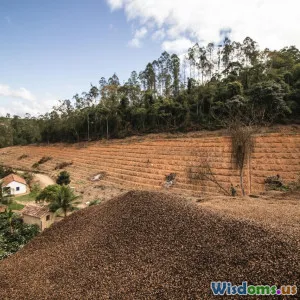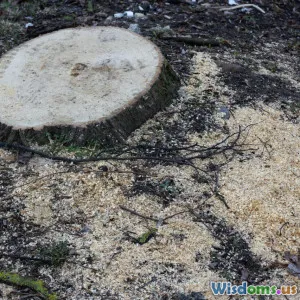
How Small Farms Can Lead the Way in Combating Deforestation
10 min read Discover how small farms play a critical role in halting deforestation through sustainable practices and community-led initiatives. (0 Reviews)
How Small Farms Can Lead the Way in Combating Deforestation
Deforestation continues to erode the planet’s lungs, threatening biodiversity, disrupting ecosystems, and contributing massively to carbon emissions. According to the Food and Agriculture Organization (FAO), an estimated 10 million hectares of forest were lost globally each year from 2015 to 2020. But amid this sobering reality, a beacon of hope shines from an unexpected source: small farms. Small-scale farmers, often overlooked in environmental discussions, hold transformative potential to halt and even reverse deforestation.
In this article, we delve deep into how small farms can become frontline defenders of forests by adopting sustainable agricultural methods, promoting agroforestry, maintaining local biodiversity, and driving community empowerment. These approaches not only protect forests but also improve livelihoods, proving that environmental and economic goals can be aligned.
Understanding the Role of Small Farms in Forest Landscapes
Small farms generally represent agricultural operations spanning less than 2 hectares in developing countries, though sizes vary by region. Globally, small farms make up about 84% of all farms and produce roughly 35–40% of the world’s food supply, underscoring their critical role in food security.
While large-scale industrial agriculture often drives deforestation through forest clearing for monocultures or cattle ranching, small farms tend to integrate with forested areas and can maintain tree cover. The FAO highlights that forests often coexist with smallholders’ lands, especially in tropical regions where deforestation rates are highest.
Understanding this intertwined relationship is key: small farmers face incentives and knowledge challenges but also possess local ecological expertise and stewardship incentives that can help forest conservation.
Sustainable Agriculture: Minimizing Forest Clearing
The Pitfalls of Conventional Expansion
Traditionally, deforestation has been linked to expanding agricultural frontiers. Large commercial farms clear vast swaths of forests to plant single crops or raise cattle, but many small farms also engage in slash-and-burn techniques to create new plots, especially where land tenure is insecure. Such practices drive forest loss even if on smaller scales.
Embracing Sustainable Techniques
However, incorporating sustainable farming practices on small farms dramatically reduces the need to clear new forest. Techniques such as crop rotation, organic fertilization, intercropping, and contour farming enhance soil fertility and yield without expanding the land footprint. For instance, in Tanzania, the use of agroecological practices by smallholders increased maize yields by 50% with no further deforestation reported.
Farmers trained in integrated pest management reduce pesticide use, preserving biodiversity and preventing soil degradation. Furthermore, conservation agriculture with minimal tillage also protects the topsoil and reduces erosion, maintaining productive land within existing farm boundaries.
These approaches allow small farmers to maximize output from limited land sustainably, easing pressure on forests.
Agroforestry: The Symbiosis of Trees and Crops
Defining Agroforestry
Agroforestry is the intentional combination of trees and shrubs with crops or livestock on the same land unit. This method mimics natural ecosystems and delivers multiple ecological and economic benefits.
Benefits Against Deforestation
By integrating trees into farming systems, smallholders restore tree cover, improve soil health, and enhance carbon sequestration. Trees provide shade, act as windbreaks, and contribute organic matter, which supports crop growth over time.
In the Amazon Rainforest region, programs encouraging small farmers to plant native tree species alongside their crops have led to a 40% reduction in deforestation incidents in targeted areas over the last decade.
Moreover, agroforestry can supply timber and non-timber products such as fruits, nuts, resins, and medicinal plants. This diversification creates additional income streams, reducing dependency on further forest clearing or risky land grabs.
Examples of Effective Agroforestry Practices
- Homegardens in Southeast Asia combine fruit trees, vegetables, and medicinal plants, creating highly biodiverse, productive ecosystems that require no forest clearance.
- Silvopastoral systems allow small-scale cattle grazing combined with tree growing, reducing grazing pressure on natural forests, as demonstrated by projects in Costa Rica.
These symbiotic practices showcase the scalability of agroforestry as a forest-friendly farming model.
Community-Led Forest Stewardship
Small farms often operate within tight-knit rural communities where knowledge sharing and collective action can amplify conservation impacts.
Land Tenure Security and Forest Protection
Insecure land tenure disincentivizes long-term investment in sustainable practices. However, when small farmers gain formal rights to their land and forests, they become motivated forest stewards.
Research from the Rights and Resources Initiative shows that Indigenous and local communities, many practicing small-scale agriculture, manage forests more sustainably. Community-managed forests in Nepal have lower deforestation rates than state-managed areas, highlighting empowerment as a vital component.
Participatory Policies and Incentives
Payment for ecosystem services (PES) schemes reward small farmers who maintain tree cover or restore degraded land. For instance, Costa Rica’s national PES program has led thousands of smallholders to conserve forests on their properties, reducing deforestation significantly.
Furthermore, farmer cooperatives invest in training and shared resources promoting sustainable farming, which improves both conservation and income.
Leveraging Technology and Market Access
Digital Tools for Monitoring and Education
Small farmers increasingly benefit from mobile apps and satellite data enabling real-time forest monitoring and agricultural advice. Initiatives like Earthworm Foundation use tech to trace deforestation risks in supply chains, helping farmers avoid forest degradation linked to commodity export.
Connecting to Sustainable Markets
Access to premium markets for organic or certified sustainable products incentivizes small farms to preserve forests and biodiversity. Certification programs such as Rainforest Alliance and Fair Trade provide not only market access but also training to enhance sustainability.
Examples from Brazil show that smallholder coffee farmers certified under sustainable schemes receive up to 20% higher prices while adopting conservation practices, reducing pressure to clear forests.
Overcoming Challenges and Scaling Impact
Despite enormous potential, small farms face systemic hurdles: limited access to credit, fragmented landholdings, lack of extension services, and policy bias towards large agribusiness.
Governments and development agencies should strengthen support systems—improving land rights, technical training, infrastructure, and access to fair markets. Public-private partnerships can mobilize resources to empower small farmers as forest custodians.
The integration of scientific research with local knowledge unlocks innovative models fitting diverse ecosystems and socio-economic contexts.
Conclusion: Turning Small Farms into Forest Protectors
Small farms are not just food producers but dynamic agents of landscape stewardship. By adopting sustainable agriculture and agroforestry, engaging in community-led forest governance, and linking to supportive markets and technologies, small farmers can lead the way in combating deforestation.
Their actions foster resilient ecosystems, mitigate climate change, and uplift rural livelihoods. Celebrating and investing in small-scale farming thus becomes an indispensable pillar of global efforts to preserve forests for future generations.
"Small farms hold the key to large-scale forest conservation." — Environmental expert Dr. Maria Delgado
Harnessing this potential requires a shift in policies and mindsets to prioritize smallholders as frontline defenders of our planet's remaining forests.
References:
- Food and Agriculture Organization (FAO). (2020). Global Forest Resources Assessment.
- Rights and Resources Initiative. (2018). Who Owns the World’s Land? Indigenous and Community Land Rights.
- Earthworm Foundation. (2023). Technology and Forest Conservation.
- Costa Rica National PES Program reports.
- Tanzania Agroecology Project data, 2019.
By reframing small farms as a key solution rather than a problem, we unlock a powerful pathway towards sustainable development and forest preservation.
Rate the Post
User Reviews
Popular Posts

















